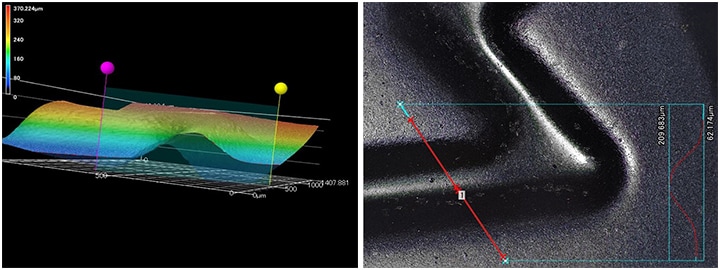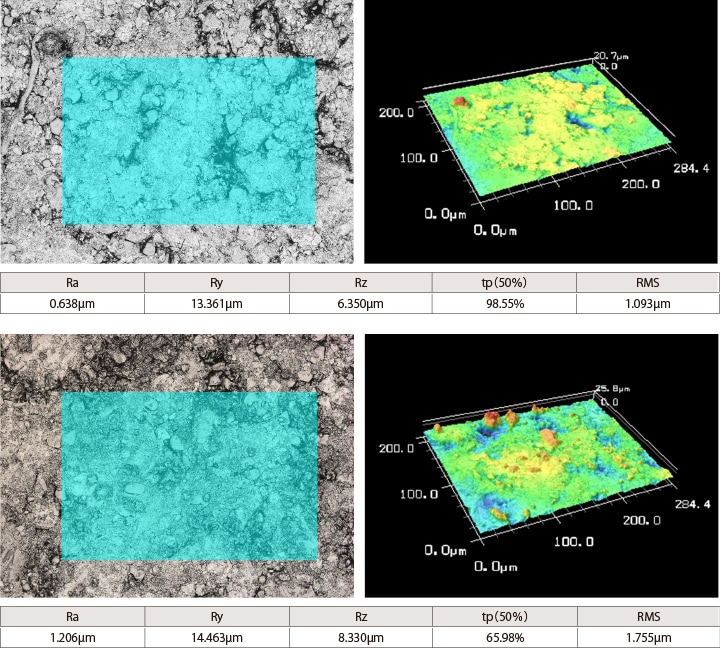Instantaneous Measurement of Medical Devices

Many medical devices are used directly on patients, so ensuring a high level of quality, safety, and efficacy is essential. Rapid medical technological innovations and steady product improvements also mean frequent evaluations and inspections are necessary. Performing evaluations and testing large numbers of samples automatically and accurately under the same conditions can save a great deal of time. This section introduces various medical technologies and devices along with example inspections using KEYENCE's 3D Surface Profiler.
- Injection Needles
- Medical Industry Applications — Injection Needles and Scalpels
- Implant
- Medical Industry Applications — Implants
- Tablets
- Medical Industry Applications — Tablets
Injection Needles
The following explains the part names of injection needles and typical types of needle tips.
Parts of an injection needle

- A
- Blade surface (bevel)
- B
- Outer diameter (gauge)
- C
- Needle length
- D
- Needle tip (blade edge)
- E
- Shaft
- F
- Needle hub (color classification by gauge number)
Needle size (G)
| G | Outer diameter (mm inch) | Hub color (Color code) | Purpose |
|---|---|---|---|
| 18 |
ø1.2 ø0.0472" |
Pink |
Blood transfusion |
| 19 |
ø1.1 ø0.0433" |
Cream |
Blood transfusion |
| 20 |
ø0.9 ø0.0345" |
Yellow |
Intravenous injection/venous blood collection |
| 21 |
ø0.8 ø0.0315" |
Dark green |
Intravenous injection/venous blood collection |
| 22 |
ø0.7 ø0.0276" |
Black |
Subcutaneous injection/intravenous injection/intramuscular injection/venous blood collection |
| 23 |
ø0.6 ø0.0236" |
Dark blue |
Subcutaneous injection/intravenous injection/intramuscular injection/venous blood collection for children/arterial blood collection |
| 24 |
ø0.55 ø0.0217" |
Medium purple |
Subcutaneous injection |
| 25 |
ø0.5 ø0.0197" |
Orange |
Subcutaneous injection |
| 26 |
ø0.45 ø0.0177" |
Brown |
Intracutaneous injection |
| 27 |
ø0.4 ø0.0157" |
Medium gray |
Intracutaneous injection |
* The ISO standard defines the color coding of needle hubs.
Typical types of needle tips
- Lancet point (regular bevel)
-
The sub edge surfaces are created on the right and left of the main surface of the needle tip to minimize resistance to the needle. This is the typical shape of needles (including injection needles). The lancet point for subcutaneous injection is called a regular bevel, with blade surface angles ranging from 12° to 14°.
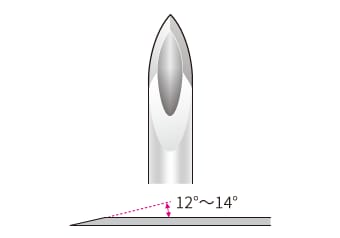
- Lancet point (short bevel)
-
This type has a shorter blade edge than regular bevel needles to reduce side effects, including tissue damage. The edge surface angle is sharp, ranging from 18° to 20°, which increases the resistance to the needle and reduces the cutting quality. This is used for blood collection where blood vessels may be damaged.
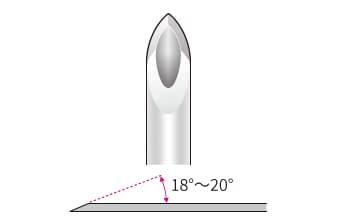
- Back cut point
-
A small edge surface is created on the back side of the main edge surface. There is a mount-shaped protrusion when you view the needle tip from the main edge surface. The cutting quality is high and it effectively mitigates pain.
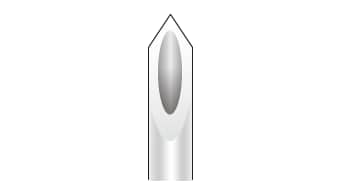
- Lancet point (back-eye)
-
The needle tip has a hole drilled in the back of the lancet point. This special hole was developed for use in dialysis. The hole on the back reduces the internal pressure on the blood vessel wall, and prevents narrowing of the blood vessel and damage to red blood cells.
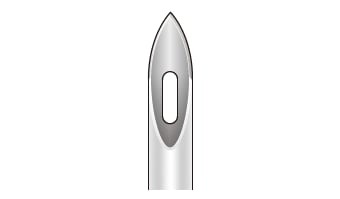
- Huber point
-
This needle tip is curved toward the bevel face, and used to inject medicine through a port implanted under the skin. The port is like a tank to store medicine. Unlike drip infusion, patients do not have to remain still during infusion, so they can work or take part in sports without any special considerations, even when the port is not in use.
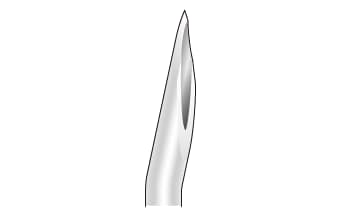
Medical Industry Applications — Injection Needles and Scalpels
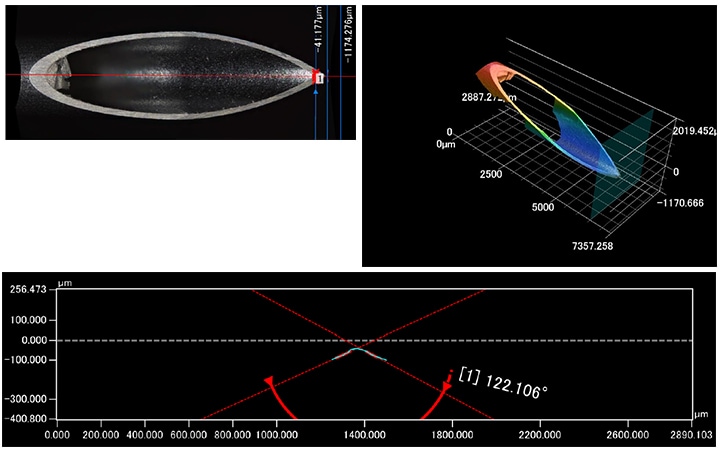

Implant
Implant is a generic name for devices and materials that are placed in a human body. Implants include cardiac pacemakers, artificial joints, and artificial dental roots.
Artificial dental roots are called dental implants.
Names of dental implant parts
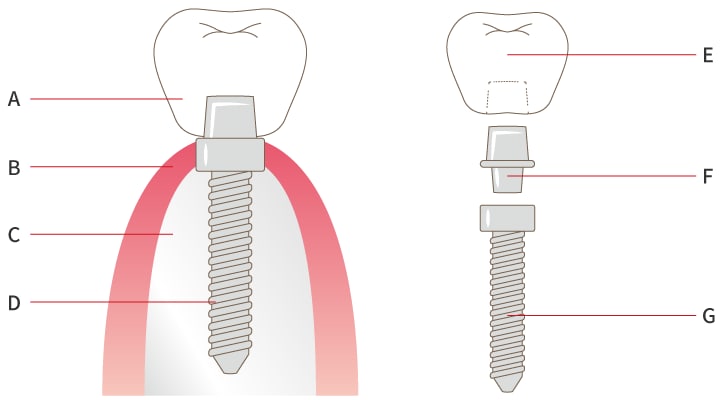
- A
- Artificial tooth
- B
- Gum
- C
- Jawbone
- D
- Implant
- E
- Crown (Artificial tooth)
- F
- Abutment (Joint)
- G
- Implant (Artificial dental root)
- Crown (Artificial tooth)
- These are artificial teeth that are fixed to abutments by cement or screws.
- Abutment (Joint)
- They are placed between implants and artificial teeth. In general, they are fixed to implants by screws.
- Implant (Artificial dental root)
- They are placed in the bone.
Materials and features of dental implants
Crown (Artificial tooth)
- Zirconia ceramics
- Zirconia ceramics have the largest benefits, including a pleasing appearance and strength. Ceramics are fused to zirconia (white non-metal material and artificial diamond).
- All ceramics
- All parts are made from ceramics. They have beautiful transparency and gloss and there is no degradation or discoloration over time. They are weaker than Zirconia ceramics or metal bond, so sometimes they break or chip.
- Metal bond
- These implants are made by fusing ceramics to metals. There is no degradation or discoloration over time, but as it includes a metal frame, the appearance isn’t as good. Also, there may be concerns regarding metal allergies depending on the metal used.
- Full-zirconia ceramics
- They are entirely made from zirconia that has excellent durability. They do not discolor or stain, but they have inferior transparency and color finishing quality as compared to ceramics.
Abutment (Joint)
- Titanium, Zirconia
- Joint parts between artificial teeth and implants. Titanium has excellent strength, resistance to corrosion, and durability, but the appearance isn’t as good. Zirconia offers strength and no risk of metal allergy. Also, as the color is close to that of natural teeth, the appearance is good.
Implant (Artificial dental root)
- Titanium
- They are placed in the jawbone. The material is titanium that is combined with bone.
Medical Industry Applications — Implants
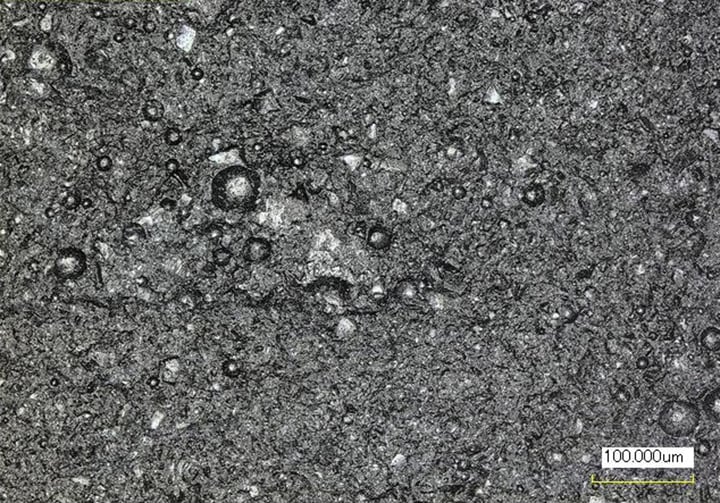
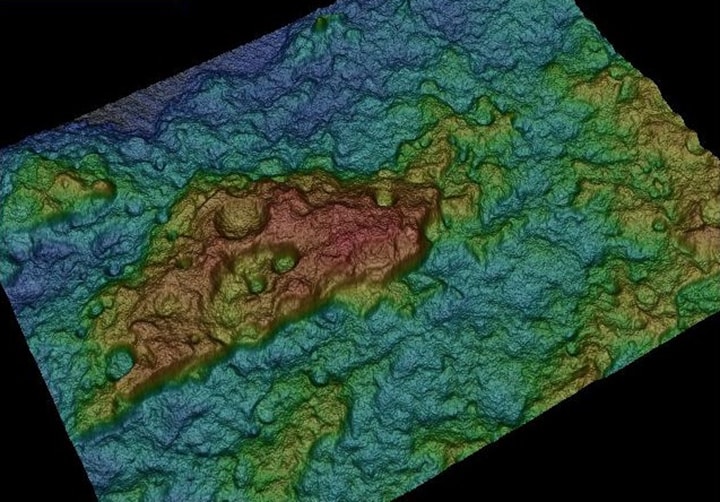
Tablets
Tablets are solid pharmaceutical products in which active ingredients are compressed and formed.
As tablets are portable, easy to understand the proper dose, and can be stored for long periods, they are the most commonly used form of medicine.
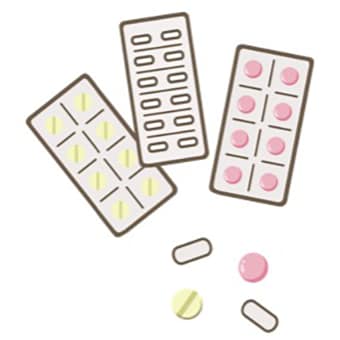
Tablet press
Rotary molding machines are generally called tablet presses. Powder is automatically measured and put into a die, and then a punch presses it to form a tablet. Filling, compressing, and discharging are performed continuously.
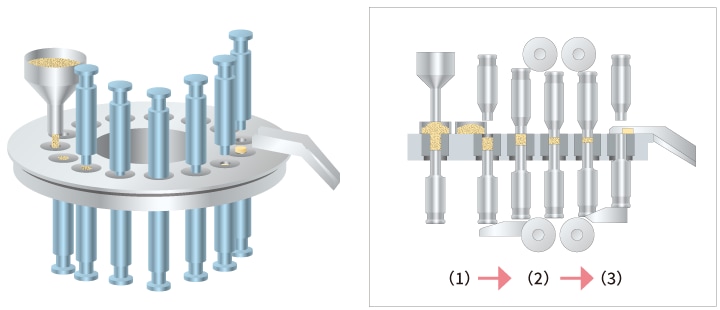
- (1) Filling
- (2) Compressing
- (3) Discharging
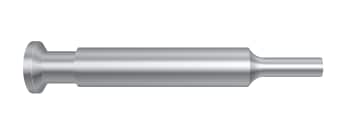
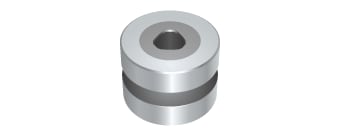
Medical Industry Applications — Tablets
